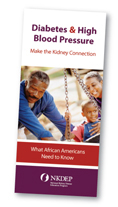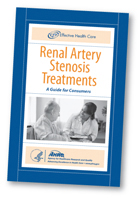Kidney Disease Research Updates
Fall 2007
Additional Resources
New Interactive Tools
New to the Interactive Health Education Tools section of the National Institute of Diabetes and Digestive and Kidney Diseases (NIDDK) website are the following podcasts:
- NKDEP Encourages Awareness About Kidney Disease
- Long-term Study of Health and Diseases in Hispanic Populations (Kidney Disease)
- High Blood Pressure Awareness
The NIDDK interactive tools section consolidates all the tools and resources about kidney disease from the National Institutes of Health and the National Library of Medicine. To access these resources, visit www.kidney.niddk.nih.gov/resources/HealthTools.
 Hemodialysis Hemodialysis
A Spanish version of the booklet entitled Treatment Methods for Kidney Failure: Hemodialysis is available from the National Kidney and Urologic Diseases Information Clearinghouse. Hemodialysis is the most common method of treating advanced and permanent kidney failure. Since the 1960s, when hemodialysis first became a practical treatment for kidney failure, hemodialysis treatments have become more effective and side effects have been minimized. This 26-page publication describes how hemodialysis works and addresses related issues such as necessary equipment and procedures, diet, financial issues, and adjusting to changes during treatment. To read or download a copy of the booklet, go to www.kidney.niddk.nih.gov/spanish/pubs/hemodialysis.
 Cystocele Cystocele
This updated fact sheet explains what causes a cystocele, options for treatment, and resources to consult for more information. A cystocele occurs when the wall between a woman’s bladder and her vagina weakens and allows the bladder to droop into the vagina. The condition can range from mild, grade 1—when the bladder droops only a short way into the vagina—to grade 3, when the bladder bulges out through the vaginal opening. This fact sheet is available at www.kidney.niddk.nih.gov/kudiseases/pubs/cystocele.
Kidney Disease and African Americans
 African Americans are disproportionately affected by kidney failure due, in part, to higher rates of diabetes and high blood pressure—the two leading causes of kidney failure—among this population. Yet many people with these conditions do not know they are at risk. The National Kidney Disease Education Program has a free brochure that explains the connection between diabetes, high blood pressure, and kidney disease. The brochure, Kidney Disease: What African Americans Need to Know, encourages African Americans to talk with their doctor or nurse about getting tested for kidney disease. It also lists steps people can take to keep their kidneys healthier longer. For a copy of the brochure, go to www.nkdep.nih.gov. African Americans are disproportionately affected by kidney failure due, in part, to higher rates of diabetes and high blood pressure—the two leading causes of kidney failure—among this population. Yet many people with these conditions do not know they are at risk. The National Kidney Disease Education Program has a free brochure that explains the connection between diabetes, high blood pressure, and kidney disease. The brochure, Kidney Disease: What African Americans Need to Know, encourages African Americans to talk with their doctor or nurse about getting tested for kidney disease. It also lists steps people can take to keep their kidneys healthier longer. For a copy of the brochure, go to www.nkdep.nih.gov.
Renal Artery Stenosis
 The Agency for Healthcare Research and Quality (AHRQ) has produced plain-language guides for consumers and health care providers outlining the latest scientific evidence on treatments for renal artery stenosis, the most common cause of correctible high blood pressure. The Agency for Healthcare Research and Quality (AHRQ) has produced plain-language guides for consumers and health care providers outlining the latest scientific evidence on treatments for renal artery stenosis, the most common cause of correctible high blood pressure.
The consumer guide includes basic information about treatment options and a comparison of treatment risks, including the impact on blood pressure and kidney function. The clinician guide includes more detailed information about these topics and “confidence ratings” of treatment evidence.
The guides are part of the AHRQ’s Effective Health Care program series, which will publish similar guides summarizing evidence on oral diabetes medications. For copies of the guides, visit www.effectivehealthcare.ahrq.gov/reports.
NIH Publication No. 08–4531
November 2007
[Top]
|






